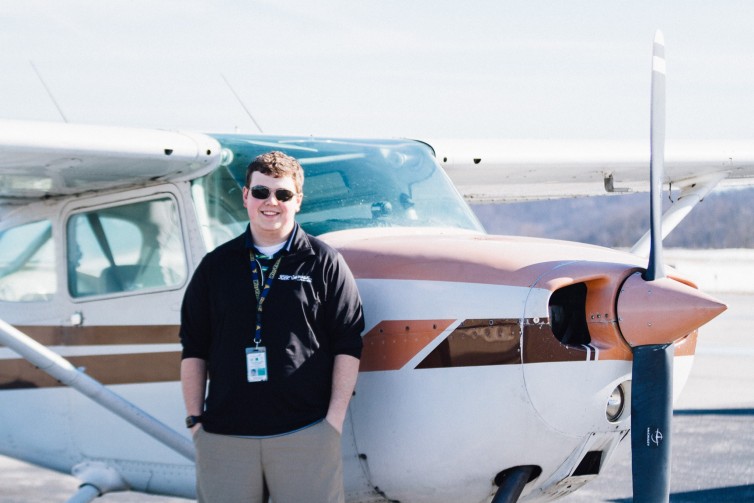
Jay with N6238D – Photo: Andrew Yianne
My name is Jay. I’m a licensed private pilot, and I have Type 1 Diabetes (T1D). While my medical condition is fully controlled, guidelines written decades ago prevent me from pursuing my dream of becoming an airline pilot. These guidelines are outdated and need to be revised. But more on that in a moment. Let me tell you how my condition was the catalyst for my love affair with flying.
When I was six, my life changed forever. I was diagnosed with T1D. I had just started kindergarten and I wasn’t sure what to expect. My life as a seemingly normal child was turned upside down. My mom, dad, and I spent three days in the hospital learning everything we could about T1D. At the time, I wouldn’t have told you my diagnoses had a positive impact on my life; however, looking back and connecting the dots, it most certainly did.
While traveling to learn more about my condition, I ended up stuck in the Cincinnati/Northern Kentucky International Airport (CVG) for nine hours. At the time, I was just nine years old. During that delay, I walked around CVG and took it all in; it was amazing. While I had flown my entire life, starting at 18 months, I somehow managed to avoid being bitten by the “AvGeek” bug. This trip was different, however. After years of flying, a nine-hour delay and the chance to observe airport operations over an extended period did me in; I was hooked on aviation.
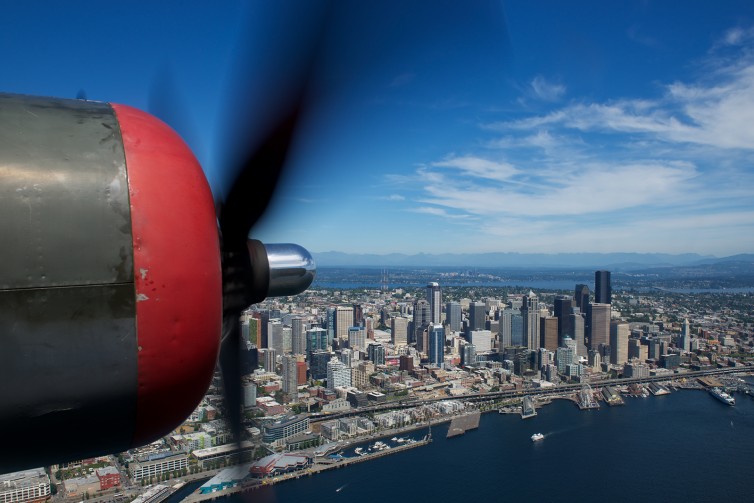
Flight is amazing – Photo: Bernie Leighton | AirlineReporter
In 2011, my dad found an article in the paper about a local airport in South Charleston, West Virginia. A few days, later we went to Mallory Airport (LID), camera in hand. While on my first “official” AvGeek trip, I explored and took many photos. I even started up a conversation with a man there who ended up letting me sit in his Mooney. It was the first time I remember manipulating the control surfaces of a plane. I was amazed. A timid tug on the yoke to the left was followed by looking out the left window to see the left aileron move upward towards the sky. It truly fascinated me how my inputs on the controls were applied in the wing.
On the way out, I noticed a sign that said “learn to fly here.” Why not? At 11 years old I took a few flying lessons and I absolutely loved it. Never did I even think having T1D might make becoming a pilot difficult.
Fast-forward to April of 2014 — after many commercial flights, an airport internship, and plenty of plane spotting, I decided to try flying lessons again.
I ended up taking flying lessons from a flight school at Yeager Airport (CRW) in Charleston, WV. I applied for a special-issuance FAA 3rd Class Medical. I went for a physical exam from a local AME (aviation medical examiner) and he deferred my paperwork to the FAA’s medical offices in Oklahoma City, OK, where presumably my application died.
After a couple of months of not hearing back from the FAA, I decided to get creative in looking for a response. Through my work as an advocate for diabetes research funding on Capitol Hill, I had built a list of contacts. I reached out to the office of one of our state’s senators, and within a few days I had my 3rd Class Medical. I was very thrilled; diabetes had lost and I had won. But it shouldn’t be this difficult. Our system is broken.
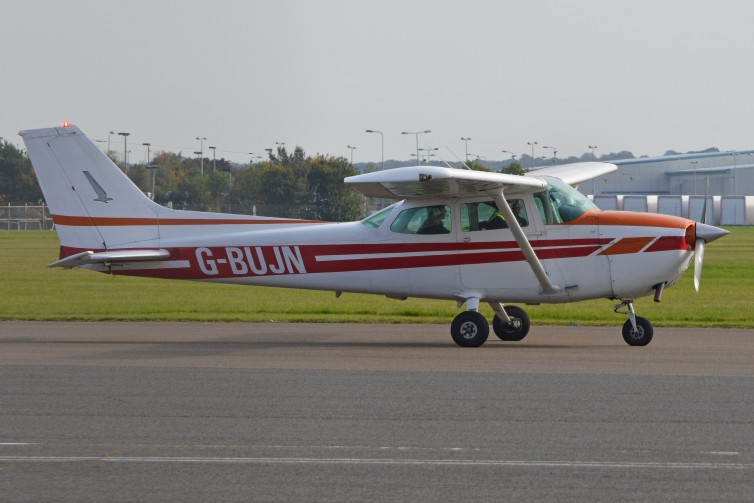
A Cessna 172N Skyhawk – Photo: Alan Wilson | FlickrCC
I flew my first solo flight on July 9, 2014 in a 1979 Cessna 172N. I was able to do one circuit in the pattern and had to stop as the ceiling dropped. I walked out of the FBO that day with a boost of confidence that could only be delivered through aviation.
A written test, endless studying, and a lot of flying later, I was ready for my FAA practical exam, the checkride. Admittedly, I was nervous. I knew how to fly and I was sure I had the knowledge to pass the oral exam. My examiner, a life-long pilot with an endless number of hours in planes from a Cessna 172 to a C130, to 737s and Learjets, was anything but intimidating. However, I was still nervous.
The oral exam went off without a hitch and I was done within 45 minutes. We went out to the sanctioned ’œpractice’ area to do maneuvers. Everything went well until… I busted on steep turns. Being the sensible and fair instructor he was, he allowed me to finish the maneuvers and go back to the airport and finish up all the required landings. I thought I had failed.
He listed the status of Private Pilot Evaluation as “incomplete”. I spent the evening at the airport with my instructor working on steep turns. The next day, I went back up with my examiner. I completed the steep turns and he instructed me to go back to the airport. I didn’t know if I had passed or failed. Once on the ramp at the FBO, with the engine shut off, my examiner reached across the small 172 cockpit, shook my hand, and said: ’œCongratulations, Jay.’ I knew at this exact moment I had just become an FAA-licensed private pilot.
As of March 19, 2015, I could officially say I held a pilot’s license before I held a driver’s license. How cool is that? My first passengers, later that day, were my mom and dad.
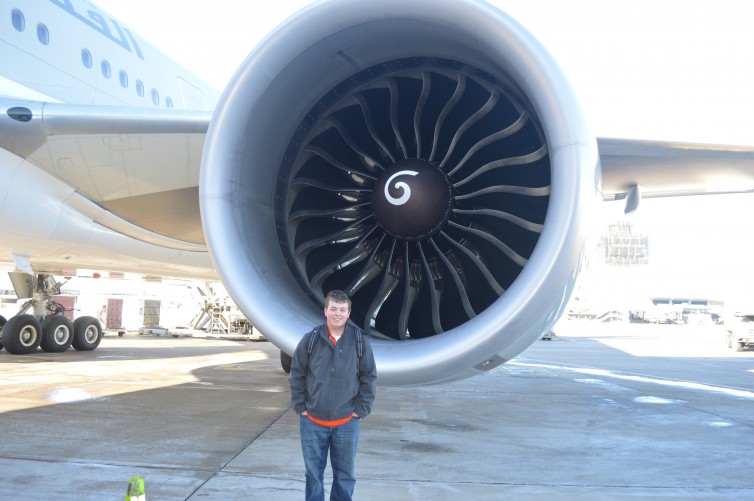
Jay standing next to the engine of a Boeing 777-300ER at IAD – Photo: Jay Haapala
What’s next? Ultimately, my goal is to be an airline pilot. I am at a pivotal point in my life and need to make some serious decisions regarding my future. If I enroll in a formal flight school, I can work all the way up to and hold an Airline Transport Pilot (ATP) License. However, without being able to obtain a First Class Medical from the FAA, I cannot exercise the privileges of the license. In an ever-changing world of aviation technology and diabetes management technology, we are at place where diabetes and commercial flying together should be a reality. It’s time. My controlled condition, with today’s outdated regulations, prevent me from pursuing my dream.
In today’s world, my diabetes can be completely controlled in all but the most extreme circumstances. T1D is an auto-immune disease, meaning you can’t catch it and it is NOT caused by lifestyle choices. I have a continuous glucose monitor (CGM) which constantly checks my blood sugar, while an insulin pump administers insulin as needed based on an algorithm. As an added safeguard, if my blood sugar goes low it will administer medication counterintuitive to the insulin. With my CGM and insulin pump, I am able to maintain control of my diabetes and safely carry out my duties as pilot in command. The technology has come a long way since restrictions were put in place. Better yet, diabetes control methods continue to advance. Heck, there are even clinical trials running right now with artificial pancreases.
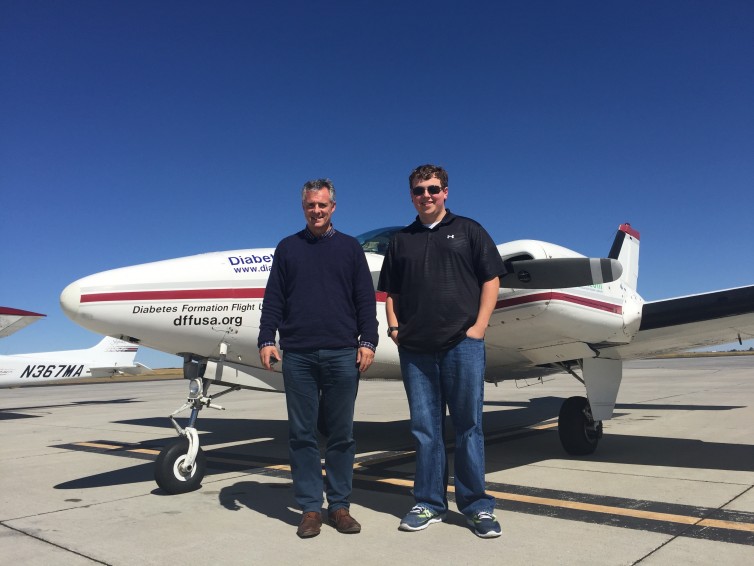
Jay, and friend Douglas Cairns, with his Beechcraft Baron (N30TB, that he flew solo around the world with T1D) after a successful leg in DFFUSA
As technology in the cockpit continues to evolve parallel to major breakthroughs in diabetes management technology, it’s time for reform. While I might not be able to beat this well-controlled disease, I believe we can beat these archaic regulations. Until I can give my own “welcome aboard” message as an airline pilot, I will continue to build time, enjoy aviation with family and friends, and fight for the T1D pilot community so that we can eventually have the same privileges as others. One day, people with Type One Diabetes will be in the cockpit of an airliner, getting you safely from point A to B, and I’m advocating to make that a reality. Join me, won’t you?
This story was written by Jay Haapala for AirlineReporter. Jay is presently attending high school in West Virginia, advocating for diabetes research as well as T1D pilot causes. In what spare time he has, he squeezes in as many pilot hours as he can. This fall, Jay will be a participating pilot in Diabetes Formation Flight USA, a formation flight to raise awareness about T1D pilots and demonstrate that they are fully capable of safe aircraft operation.
Jay, thank you for sharing your AvGeek origin story, and helping us to understand the barriers which stand in the way of you reaching your dream. I couldn’t agree more, it is time to revisit the rules. I don’t have all of the answers BUT it’s clear that we’ve come a long way since the T1D exclusion was put in place decades ago. It’s time to revisit this. Thank you for advocating for your fellow T1Ds. I wish you the best in your very bright future.
JL | AirlineReporter
As the parent of a T1D son who once aspired to be an astronaut (and got a degree in aerospace and mechanical engineering), thanks for an inspirational (and emotional) story.
Jay, thanks for a great story,,,,,and best wishes on pursuing your dream,,,,Im a retired Airline employee, ground based,,and aviation is a wonderful career……best of luck!
Two quick thoughts:
1) Yup! Young Jay is a genuine, card-carrying AvGeek.
2 As one who knows more than a bit about T1D and current disease management processes, this young pilot knows his stuff inside out. When those antiquated regulations were imposed decades ago, they WERE appropriate and necessary for the protection of the general public. In 2016 that is simply no longer true. With a long, proven history of excellent glucose control there is NO legitimate reason to deny this young fellow – and many others with T1D the full rights and benefits of a First Class Medical Certificate. None! Yes, the First Class Certificate should be subject to extremely careful review via the Special Issuance procedures, but if all measures suggest the excellent control that Jay reports, IMO he is entitled to an unrestricted certificate. Yes, the regulations should reflect the state of the science in 2016, and Yes, I wish him every success!
Jay, congratulations on all your achievements and the success that lies ahead of you in the future. I’ve been a T1D for 25 years now, diagnosed shortly after, my 18th birthday. Up to that point in my life, I was absolutely obsessed with aviation and had my career goal set on being a commercial airline pilot. I was, at the time, pursuing my private pilots licence. Once I found out I was T1D, life changed and my dream of becoming a pilot ended. Even though I am in Canada, I am sure many of the same rules apply in the USA when it comes to this kind of thing. Kudos to you for making a difference and fighting the fight. Continue what you are doing and I wish you nothing but luck and happiness once you achieve your dream. Well done.
As a former 747 captain with a major international airline, I was forced to leave my career when oral medications, diet, and exercise could no longer control my Type 2 diabetes, and it became necessary to go on insulin. At first, I was bitter and angry, feeling that my insulin pump could control my blood sugar levels better than I could when I was on the oral meds, justifying further renewals of my Special Issuance FAA First Class Medical Certificate. Over time, however, after experiencing a few episodes of hypoglycemia brought on by the insulin, I found it easier to justify the FAA’s denial of my certificate, and have come to accept that it is probably for the best that diabetics on insulin not be placed in charge of an aircraft full of passengers. I’m sorry for your disappointment, but I agree with the FAA on this one.
@Richard Maldic: There is merit in your thoughts, but I respectfully suggest that we agree to disagree. I’m pleased to know that you have apparently adjusted well to your certificate loss. I do not know (or care) about your age, but as a senior 747 left driver, you were far closer to normal retirement than is author Jay, at 17 or 18. With the constant advances in T1D care in effect and in the pipeline, I believe that young Jay should continue his quest, yet clearly understanding that he may not prevail. By the time that he actually needs that First Class Certificate, it may be possible. As noted earlier, I also believe that T1D is one that should continue to require a Special Issuance review – every time. No two cases are the same; some pose a limited, acceptable risk and some simply do not. Congratulations on your long and successful career, sir.
Actually, your poor management made “you” ineligible. Constant glucose monitoring and pre and in flight checks are more than sufficient to keep all safe. It’s working in both England and Canada already.
What is the basis for your contention that Capt. Mladic’s diabetes was “poorly managed?” The progression of treatment that he describes shows careful decision making and correct treatment at all stages. Why do you have to be insulting in order to make your point? Do you get some strange satisfaction this way?
Jay, thanks for a really interesting article. You have explained a dilemma that I know next to nothing about. Your excellent coverage leaves me with just one part of your campaign that isn’t clear. You state “my diabetes can be completely controlled in all but the most extreme circumstances”. What are those extreme circumstances? Wishing you all the best in your career.
You should see what I had to go through simply because I couldn’t see a silly number in a silly blot of colors.. The Ishihara color vision test. Yup.. Delayed my career by 10 years. The FAA allows several tests and if they don’t work you can take a real world test consisting of a tower light signal from 1500 feet (was used for lost comm but now pretty much made obsolete by cell phones and several radios on board), aviation chart color test (yes I had to name colors like a 5 year old instead of actually identifying what the chart was telling me which is totally doable without color in most cases) and a night flight around the pattern with an FAA examiner to ID airport light colors, cockpit colors, signs, etc. Thankfully this is an option but still cumbersome. If you are only mildly color vision deficient as I am, you can still be an airline pilot with absolutely NO compromise in safety. There are MANy flying today with worse than mild deficiencies and you probably were on a flight with one at the controls. So yes.. The system needs updated big time, and I’d make a pretty poor interior designer. But at least it no longer outright excludes people as long as they are willing to put up a long and difficult battle. As long as you see most solid colors you should be able to pass. Best of luck!
I too am color deficient and am restricted. I attempted the FAA Test and missed ONE color on the paper chart. I am not allowed to night fly because of that!
thanks for sharing your story I wish you every success
Keep up the good work Jay, and don’t give up. Rules are changing as I write this. (Not very fast, and not to everyone’s benefits,) so don’t give up. We need more of your youthful enthusiasm at all of our airports, as well as positions of authority in our national and state capitals.
I have a (lapsed) special issuance third class, for type II, with oral medication. Now waiting for that new third class reform to come into being, then maybe, just maybe, I’ll be able to get back in the air.
Again, keep up the good work, and thank you for a good story.
Just got back from. Heart catheter and stent procedure back in May. FAA required a second, follow up heart cath which my cardiologist was against doing. Heart Association guidelines oppose it, also and the doc was actually fined by the government for performing a non necessary procedure. Think about that: one govt agency, the FAA, required a procedure that resulted in another govt agency fining the doc.
To say that he FAA needs to update their medical requirements across the board is an understatement.
Good luck to Jay, hope to see him in the Boeing cockpit with me someday. ,
Wretched bureaucrats with small minds and smaller world views. I have type II, and take an antidepressant on the prohibited list. Anachronistic and needlessly aggravating. No one is protected by these arcana, but good luck getting the dysfunctional congressional majorities to do anything sentient or even human about it or anything else important to American lives.
This is an excellent example of how government and its regulations fail to keep up with technology. Bureaucratic systems reject and inhibit positive change and the bureaucrats themselves simply want to keep putting the pegs in the same holes. With the systems available to manage your disease, you present no greater risk as a pilot than one who meets the outdated medical standards. Good luck in your pursuit of your dream, and, ultimately, the left seat!
I have color vision deficiency and feel some of the same frustrations! There is currently corrective lenses to help with color deficiency but they are not approved for use in passing color testing. I guess color correcting glasses are not the same as vision enhancing glasses!
Welcome to the brotherhood, Jay!
Sadly, I have a host of issues that the FAA likes to get all excited about, even though none has ever been a cause of sudden incapacitation, nor in my estimation, likely to cause sudden incapacitation. My last 3rd class medical certificate cost me about $3,500, and that was in 2002. Today , with a few new issues added to the list, I’m sure it would cost upwards of $20,000 and many months of tests, letters, back and forth, and arguing. I could actually afford to fly – if only I didn’t have to spend so much proving it. So, the proposed legislation to eliminate the 3rd class for only those who’ve gotten one in the last 7-8 years will do little to restore GA in 2018, (the soonest it is likely to get considered again), and certainly not ever for me. If only someone would promote a rule allowing any two non-medically certified pilots who both still hold valid driver’s licenses to fly TOGETHER… that would help a lot. With the chances of sudden incapacitation astronomically low to begin with, the chances of two simultaneous incapacitations are, absurdly vanishingly remote.
Jay, welcome to the community. I, myself, am a T1D and obtained my 3rd class last year. I have yet to take a lesson though, do to money. However, I agree that a T1D can have an ATP as long as the co-pilot is not a T1D. This is how they do it in the UK. It’s the one thing that I’ve thought about writing to congress to get changed. My hobby is aviation photography, and that really gets the #avgeek bug going. Good luck in your endeavors and I may see you at the one of the T1D avation events.
Jay, thank you for writing this and bringing more light to this subject. My son is 14 and has nearly 20 hours in a 172. His dream is to be a commercial pilot, even if that means moving to the UK. It’s insane to think that our government is so short sighted to making changes that in theory should be simple to make. I recently read a recommendation from I believe the American Diabetes Association to Congress advocating for this change. It is sad that young people’s dreams can be shattered in America because of uninformed bureaucrats regarding incredible research and actual treatment progression for diabetes and other ailments. The American dream I guess has limitations, but I hope together we can make changes, especially with the decreasing number of young pilots in this world. Please let me know how we can help champion the cause and congrats on getting your license!
Sadly, it is the same case here in the UK. Although they allow pilots with T1D to fly in the UK, you have to already have your medical and be flying to do so. Unfortunately, if your are diagnosed before starting your training you will be unable to obtain a class 1 medical, restricting you to only a PPL with a third class medical. I have not come across any country that will issue you a class 1 if you already suffer from this condition. I really hope this is something that will change soon, although it could take 2,5 or even 10 or more years! I planned on starting my pilot training next year but this dream has sadly come to an end after being diagnosed T1D last week. I wish everyone who is diagnosed with a condition that prevents them from flying commerically the best of luck and hopefully we can follow our career soon!
I’m a T1D since the age of 9, I’m now 24 years old and I just WISH I can become a commercial pilot. I finished a software engineering (my second passion) degree from Canada and I’m now working in the U.A.E. I’m on an insulin pump and i’m fully controlling my diabetes. The rules must be changed as the number of diabetic people is increasing around the globe, pilot shortage is become more and more and diabetes treatment, cure is being developed day by day. FAA, JAA, GCAA you need to look at us and help us accomplish our dreams.
Jay, and anyone else interested in getting these rules changed, please contact my email directly Ta************@****ud.com. I too am a T1D who dreams of flying in that left seat of a major airliner. Let’s put our heads together to help so many of us realize our dream.
A little background on me, I am 19 years old, and am currently a call center sales manager, but my dream is to fly. I have had T1D for almost 17 years now. I was on the pump until last month, and I have switched to all injections now, and I love it . I hope to hear from many of you soon.
Regards,
Tanner Martin